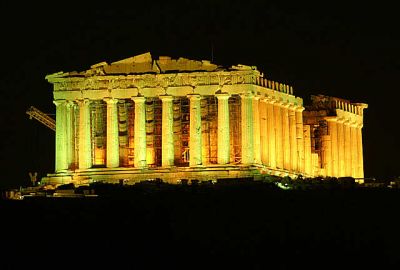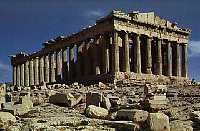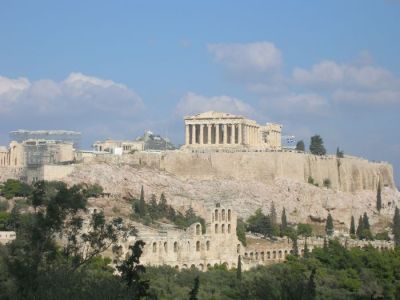|
|
The Akropolis of Athens
Parthenon Marbles
 An
acropolis in ancient Greece was a fortified hill or cliff (the
word means "high town"); many Greek towns had (and
have) an acropolis. The famous Acropolis in Athens is the
steep limestone hill whereupon stand the Parthenon, the
Erechtheion, the Propylaea, the Temple of Athena Nike, the
modern Acropolis Museum, and the ruins of many other
monuments.
An
acropolis in ancient Greece was a fortified hill or cliff (the
word means "high town"); many Greek towns had (and
have) an acropolis. The famous Acropolis in Athens is the
steep limestone hill whereupon stand the Parthenon, the
Erechtheion, the Propylaea, the Temple of Athena Nike, the
modern Acropolis Museum, and the ruins of many other
monuments.
The Acropolis provided strong defensive walls and a vantage
point for the fortress and royal palace that stood here until
the 6th century BC, when it became a sanctuary for various
deities. The monuments seen today are the result of a campaign
by Pericles to beautify Athens, in order to assure its place
as a center of culture.
The top of the Acropolis requires a strenuous, uphill hike of
ten minutes, and there are no facilities for wheelchair users.
Visitors enter via the Beule Gate, built by the Romans in the
3rd century. Climbing the stairway, they come to the
Propylaea, the original Greek entrance. Its once monumental
doorways, gold-encrusted marble ceilings, and painting gallery
are now in ruins.
 Just outside the Propylaea, the Temple of Athena Nike features
some original, although substantially damaged, friezes. It has
been restored twice, once in the 19th century and later in the
1940s. The interior is closed to the public.
Just outside the Propylaea, the Temple of Athena Nike features
some original, although substantially damaged, friezes. It has
been restored twice, once in the 19th century and later in the
1940s. The interior is closed to the public.
The most prominent and famous structure is the Parthenon, a
temple originally dedicated to the virgin goddess Athena.
Begun in 447 BC and finished some nine years later, the
Parthenon is the largest Doric temple in Greece. It once
housed a splendid ivory and gold statue of Athena, carved by
Phidias (490?–430 BC), who also sculpted the magnificent
160-meter (525-feet) frieze of the Panathenaia, which
decorated the pediments with hundreds of human and animal
figures. Various conquerors over the centuries have used the
temple as a church, a cathedral, and even a Turkish mosque.
 The Parthenon was even used as a gunpowder magazine; during a
battle between the Turks and the Venetians in the 17th
century, a stray shell ignited the powder, blowing 14 columns
to pieces. In the early 19th century, the British Ambassador
Lord Elgin obtained permission from the Ottoman authorities to
remove a large portion of the frieze of the Panathenaia, and
take it to England, where it is now displayed in the British
Museum as the Elgin Marbles. (Other pieces are on display in
the Acropolis Museum.) Today, the Parthenon suffers greatly
from the city's smog, which is gradually eating away its
Pentelic marble structure.
The Parthenon was even used as a gunpowder magazine; during a
battle between the Turks and the Venetians in the 17th
century, a stray shell ignited the powder, blowing 14 columns
to pieces. In the early 19th century, the British Ambassador
Lord Elgin obtained permission from the Ottoman authorities to
remove a large portion of the frieze of the Panathenaia, and
take it to England, where it is now displayed in the British
Museum as the Elgin Marbles. (Other pieces are on display in
the Acropolis Museum.) Today, the Parthenon suffers greatly
from the city's smog, which is gradually eating away its
Pentelic marble structure.
The Erechtheion, an Ionic temple built in 407 BC, housed some
of the holiest shrines of ancient Athens. The pediment of the
southern portico is supported by the six Caryatids, statues of
young women. The present statues are copies; one of the
originals is in the British Museum, while the remaining five
are now in the Acropolis Museum, at the southeast corner of
the Acropolis. |